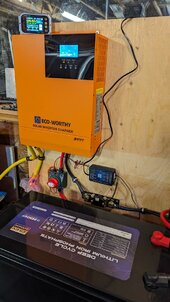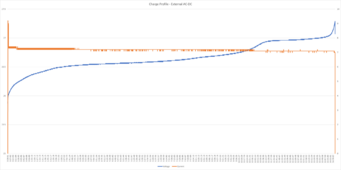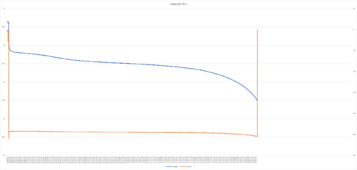I am hoping to get insight from you guys about an issue I am seeing on a recently purchased setup. I have been dreaming of the day I could replace my flooded batteries in our motorhome with LifePo4. Doing my research I understood that more than just the batteries need to be replaced (i.e. charge controller, alternator charging DC-DC).
I settled on doing a 24v system. Being in Canada our choices are a lot more limited for products we can get. Ultimately I decided to go with an Eco-Worthy 3000W 24v all-in-one paired with a Renogy 24v 200Ah self-heated LifePo4 (200A charge/discharge). I also had an existing Junctek KG140F 400A shunt.
All-in-one: https://ca.eco-worthy.com/products/...r-inverter-60a-controller-for-off-grid-system
Battery: https://ca.renogy.com/core-24v-200ah-deep-cycle-lithium-iron-phosphate-battery/
Shunt: https://www.aliexpress.com/item/1005005821745128.html
The all-in-one is similar to an SNRE HF2430U60-100 or PowMr
I received the battery and inverter on Feb. 8th 2024 and kept the battery inside my house. I proceeded to wire up a test rig before installing it in my RV to work out any bugs. From the positive battery terminal I go to a 200A T-Class fuse, into a disconnect switch and then into the inverter. From the negative terminal I go into the shunt and then into the all-in-one.

On Feb. 11th (4 days after receiving it) I hooked the battery up for the first time and powered on the inverter. I updated the all-in-one configuration from "GEL" to "L08" and set the Boost Charge Voltage to 29v as this was what was listed on the battery manual. I reduced the AC-DC charging to 30A as to not stress my 15A/120v main circuit. I plugged the all-in-one into mains and it began to charge the battery and eventually indicated the charging was complete.
The next day I (4 days since I had the battery) I proceeded to do a capacity test. I plugged a 1200W heat gun into the inverter and let it run. The shunt showed ~50A draw and I confirmed this with a clamp meter. During this test I watched the voltage and it seemed to be dropping quicker than expected. Eventually the BMS disconnected the battery. The shunt showed only ~100Ah was used. The elapsed time was ~2 hours so this lines up. This was odd to me as this was suppose to be a 200Ah battery so I only got 1/2 the capacity I was expecting.
Naturally, I decided to run the test again so I charged the battery until "full" then ran the test again and again only got 100Ah from it.
At this point I was worried the all-in-one may not be fully charging the battery (and this may still be an issue) so I ordered a AC-DC LifePo4 10A charger. This took several days to arrive but when I did I charged the battery again (took a while).
I ran another capacity test and found that I still only got ~100Ah (50A @ 2hrs).
During charging from the all-in-one I've observed the current steady at 30A and the voltage slowly increases. I have never observed it hitting 29v while charging but I did dump the shunt log at one point and see that it hit a max voltage of 29.4 at some point.
Some other things to note - as I did not want to burn my house down so I did my initial tests in my garage and the ambient temperature went as low as 4C (39F). This shouldn't be a problem though as this is a "cold weather" LifePo4 battery and the temp never went below 0C (32F). I have since moved it all into my house.
So question is - did I do something wrong? Could it be a bad battery? Is the all-in-one not working as expected?
Even if I am not achieving 100% SOC I should be getting more than 50%
I've opened a claim with Renogy about the battery and is currently in progress but I would like to know from your experience if anything jumps out as odd or wrong with what I have done so far?
I settled on doing a 24v system. Being in Canada our choices are a lot more limited for products we can get. Ultimately I decided to go with an Eco-Worthy 3000W 24v all-in-one paired with a Renogy 24v 200Ah self-heated LifePo4 (200A charge/discharge). I also had an existing Junctek KG140F 400A shunt.
All-in-one: https://ca.eco-worthy.com/products/...r-inverter-60a-controller-for-off-grid-system
Battery: https://ca.renogy.com/core-24v-200ah-deep-cycle-lithium-iron-phosphate-battery/
Shunt: https://www.aliexpress.com/item/1005005821745128.html
The all-in-one is similar to an SNRE HF2430U60-100 or PowMr
I received the battery and inverter on Feb. 8th 2024 and kept the battery inside my house. I proceeded to wire up a test rig before installing it in my RV to work out any bugs. From the positive battery terminal I go to a 200A T-Class fuse, into a disconnect switch and then into the inverter. From the negative terminal I go into the shunt and then into the all-in-one.

On Feb. 11th (4 days after receiving it) I hooked the battery up for the first time and powered on the inverter. I updated the all-in-one configuration from "GEL" to "L08" and set the Boost Charge Voltage to 29v as this was what was listed on the battery manual. I reduced the AC-DC charging to 30A as to not stress my 15A/120v main circuit. I plugged the all-in-one into mains and it began to charge the battery and eventually indicated the charging was complete.
The next day I (4 days since I had the battery) I proceeded to do a capacity test. I plugged a 1200W heat gun into the inverter and let it run. The shunt showed ~50A draw and I confirmed this with a clamp meter. During this test I watched the voltage and it seemed to be dropping quicker than expected. Eventually the BMS disconnected the battery. The shunt showed only ~100Ah was used. The elapsed time was ~2 hours so this lines up. This was odd to me as this was suppose to be a 200Ah battery so I only got 1/2 the capacity I was expecting.
Naturally, I decided to run the test again so I charged the battery until "full" then ran the test again and again only got 100Ah from it.
At this point I was worried the all-in-one may not be fully charging the battery (and this may still be an issue) so I ordered a AC-DC LifePo4 10A charger. This took several days to arrive but when I did I charged the battery again (took a while).
I ran another capacity test and found that I still only got ~100Ah (50A @ 2hrs).
During charging from the all-in-one I've observed the current steady at 30A and the voltage slowly increases. I have never observed it hitting 29v while charging but I did dump the shunt log at one point and see that it hit a max voltage of 29.4 at some point.
Some other things to note - as I did not want to burn my house down so I did my initial tests in my garage and the ambient temperature went as low as 4C (39F). This shouldn't be a problem though as this is a "cold weather" LifePo4 battery and the temp never went below 0C (32F). I have since moved it all into my house.
So question is - did I do something wrong? Could it be a bad battery? Is the all-in-one not working as expected?
Even if I am not achieving 100% SOC I should be getting more than 50%
I've opened a claim with Renogy about the battery and is currently in progress but I would like to know from your experience if anything jumps out as odd or wrong with what I have done so far?







